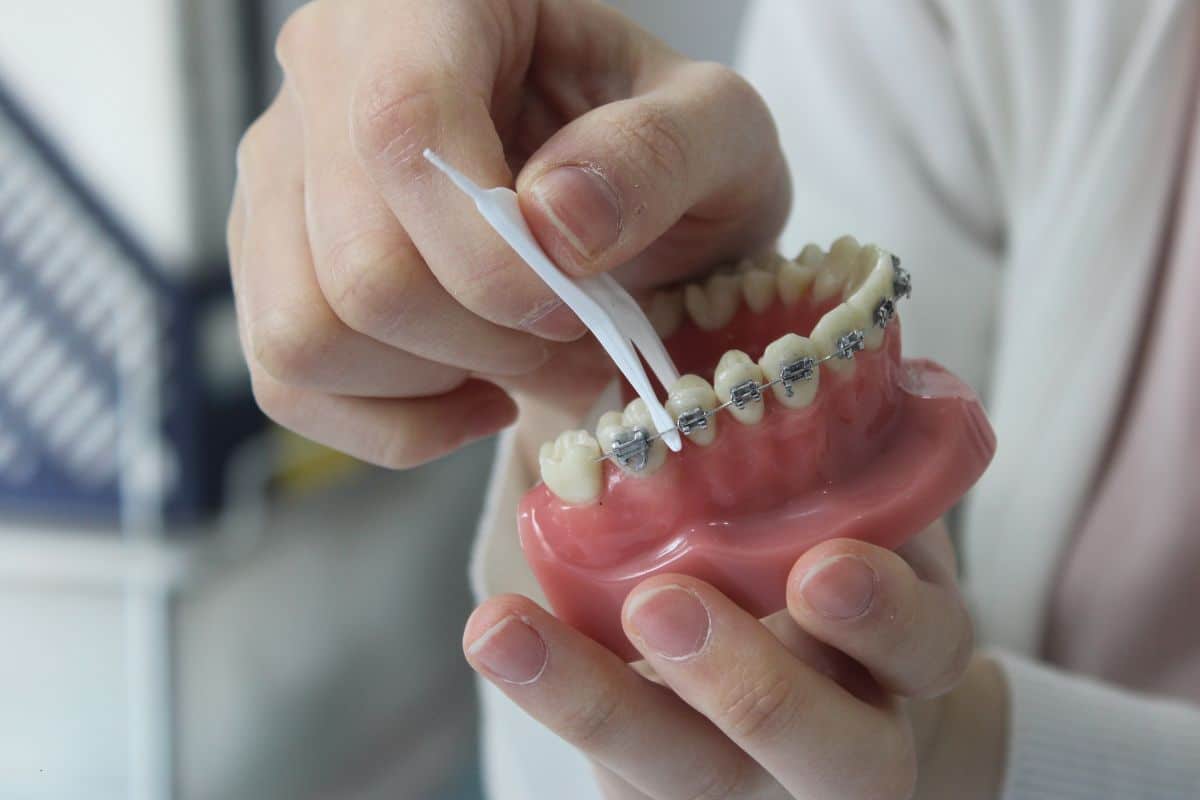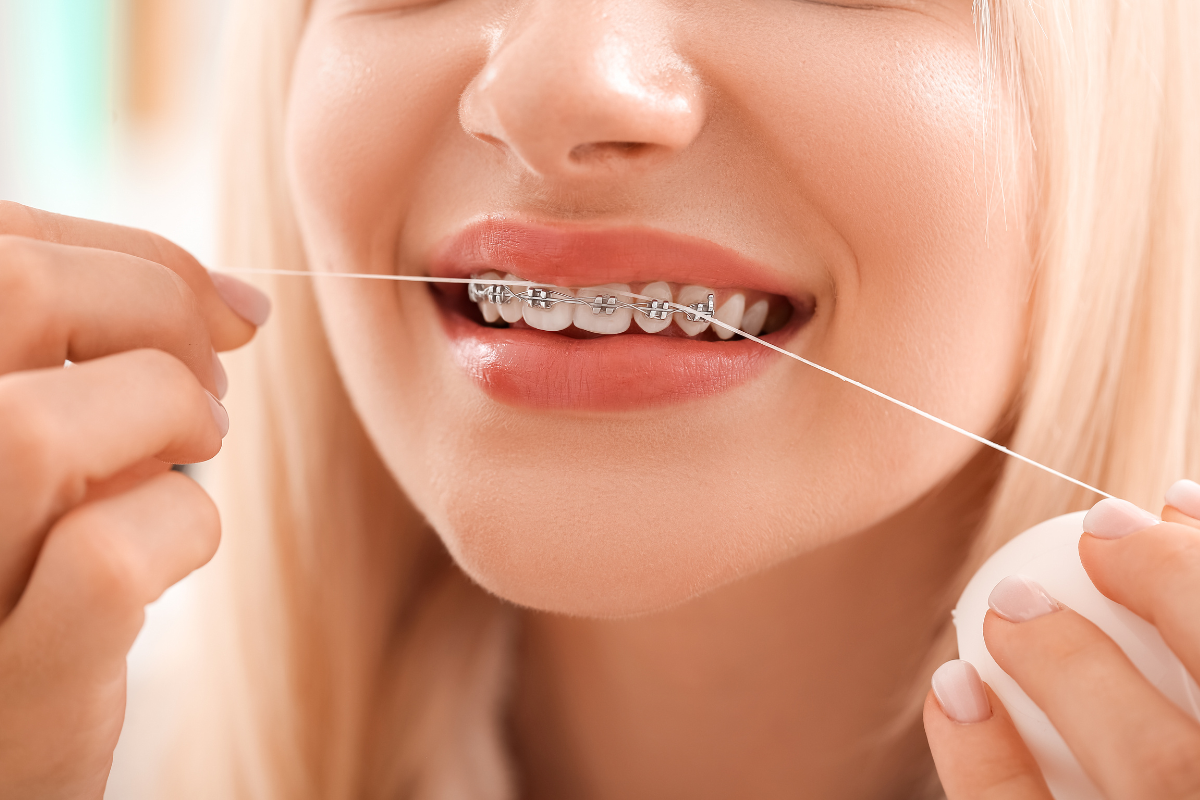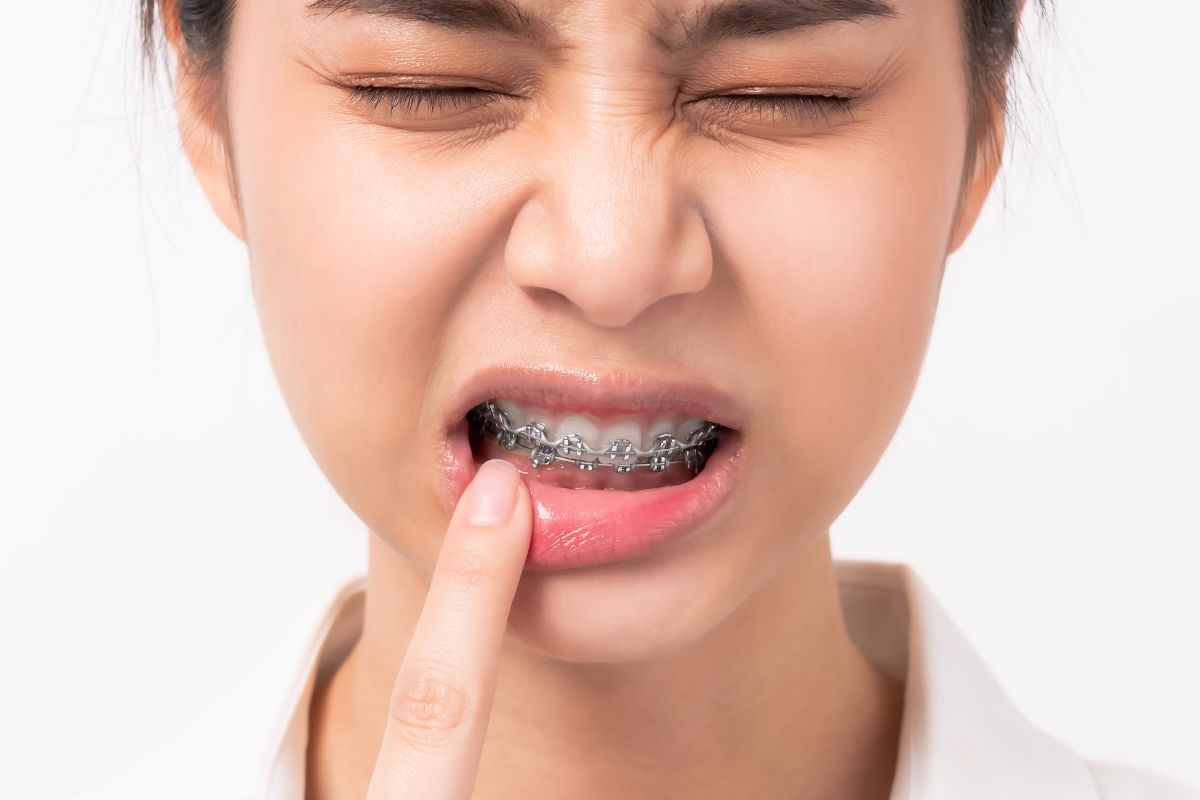Flossing with braces isn’t exactly fun, but skip it, and you’re asking for trouble.
Those wires and brackets are magnets for food and plaque, which can quickly turn into cavities and gum problems.
In this guide, we’ll show you how to floss with braces the right way, what tools make it easier, and why it’s a must for keeping your smile healthy while you’re straightening it out.
How to floss with braces?
Use a floss threader to guide the floss between the braces. Gently move the floss up and down to clean between the teeth and around the brackets. It takes a little extra time but keeps your teeth clean!
Key Takeaways
- Flossing with braces helps to remove food particles and plaque that get trapped between the brackets and wires.
- Proper flossing can prevent gum disease and cavities, ensuring your teeth remain healthy throughout treatment.
- Special tools, such as floss threaders or orthodontic floss, can make flossing easier with braces.
Why Flossing with Braces Is Essential

Braces are an excellent way to straighten your teeth, but they can also make maintaining oral hygiene more difficult.
The brackets and wires create hard-to-reach areas in your mouth, providing plenty of opportunities for food and bacteria to hide.
Flossing is a crucial step in cleaning these areas, and it helps to:
- Prevent plaque buildup that can lead to cavities
- Keep your gums healthy by preventing gingivitis and gum disease
- Avoid bad breath caused by trapped food particles
- Maintain a clean and fresh feeling in your mouth
Flossing with braces may require some extra effort and patience, but the results are worth it for long-term oral health.
Tools You’ll Need to Floss with Braces
Flossing with braces requires special tools designed to get the job done effectively.
Regular dental floss may be difficult to maneuver with the wires and brackets in place, so consider these tools:
Floss Threaders
Floss threaders are small devices that help you thread dental floss under the archwire of your braces. They work by guiding the floss into tight spaces between the brackets and teeth.
How to Use: Thread the floss through the threader, then use the device to pull the floss under the wire. Once it’s in place, gently move the floss up and down to clean between your teeth.
Orthodontic Floss
Orthodontic floss is specially designed for people with braces. It’s thicker and sturdier than regular floss and is often coated with wax to make it easier to slide under the braces’ wires.
How to Use: Use the orthodontic floss as you would regular floss, gently guiding it between the teeth and under the wires. The thicker design allows you to clean more effectively.
Floss Picks
Floss picks with a built-in handle can make flossing easier, especially if you're on the go. Some floss picks also come with a small hook that helps lift the floss over the braces wire.
How to Use: Hold the pick and insert the floss into the spaces between your teeth, gently moving it up and down.
The handle gives you better control and allows you to floss more comfortably.
Water Flossers
Water flossers are an excellent addition to your oral hygiene routine, especially if you find it challenging to use traditional floss.
A water flosser uses a stream of pulsating water to remove food particles and plaque from between the teeth.
How to Use: Direct the stream of water between the brackets and along the gum line to clean your teeth effectively.
This method is great for people who have difficulty flossing with traditional tools.
How to Floss with Braces: A Step-by-Step Guide
Flossing with braces takes a little more time and attention to detail, but with the right technique, it can become a quick and easy part of your routine. Here’s how to do it:
Step 1: Choose the Right Tools
Select the flossing tool that works best for you. Floss threaders, orthodontic floss, or a water flosser can all help you clean between your teeth effectively.
Make sure you have everything you need within reach before you start.
Step 2: Thread the Floss Under the Wire
If you’re using a floss threader or orthodontic floss, start by threading the floss under the wire of your braces.
For floss threaders, this involves pulling the floss through the threader and gently guiding it under the wire. If using orthodontic floss, simply slide it under the archwire.
Step 3: Floss Between Each Tooth
Once the floss is under the wire, gently move the floss up and down between your teeth. Be careful not to snap the floss or pull too hard, as this could damage your braces.
Take your time and make sure to clean each space thoroughly.
Step 4: Move to the Next Section
Once you've finished flossing one section, remove the floss from under the wire and move on to the next set of teeth.
Repeat the process for each set of teeth, making sure to floss every gap to remove food particles and plaque.
Step 5: Rinse Your Mouth
After you’ve flossed all areas of your mouth, rinse your mouth with water or an antimicrobial mouthwash to help remove any leftover debris.
This will also help freshen your breath and reduce the risk of gum disease.
Frequently Asked Questions (FAQs)
1. How often should I floss with braces?
You should floss at least once a day, preferably after every meal. Flossing more often helps keep your braces clean and reduces the risk of plaque buildup.
2. Can I use regular dental floss with braces?
You can use regular dental floss with braces, but it may be more challenging to get the floss under the wire. Using a floss threader or orthodontic floss can make the process easier.
3. Is flossing with braces necessary?
Yes, flossing is essential with braces. It helps prevent cavities, gum disease, and plaque buildup that can cause long-term damage to your teeth and gums.
Conclusion
Flossing with braces may take a little extra time and effort, but it’s an essential part of maintaining good oral health during your orthodontic treatment.
By using the right tools and following a regular flossing routine, you can keep your teeth clean, prevent gum disease, and achieve the smile you’ve been working toward.
If you’re unsure about how to floss with braces or need assistance, don’t hesitate to consult with your orthodontist for personalized advice.
Flossing is a small investment of time that will pay off in the long run with a healthier smile.
%202.svg)



